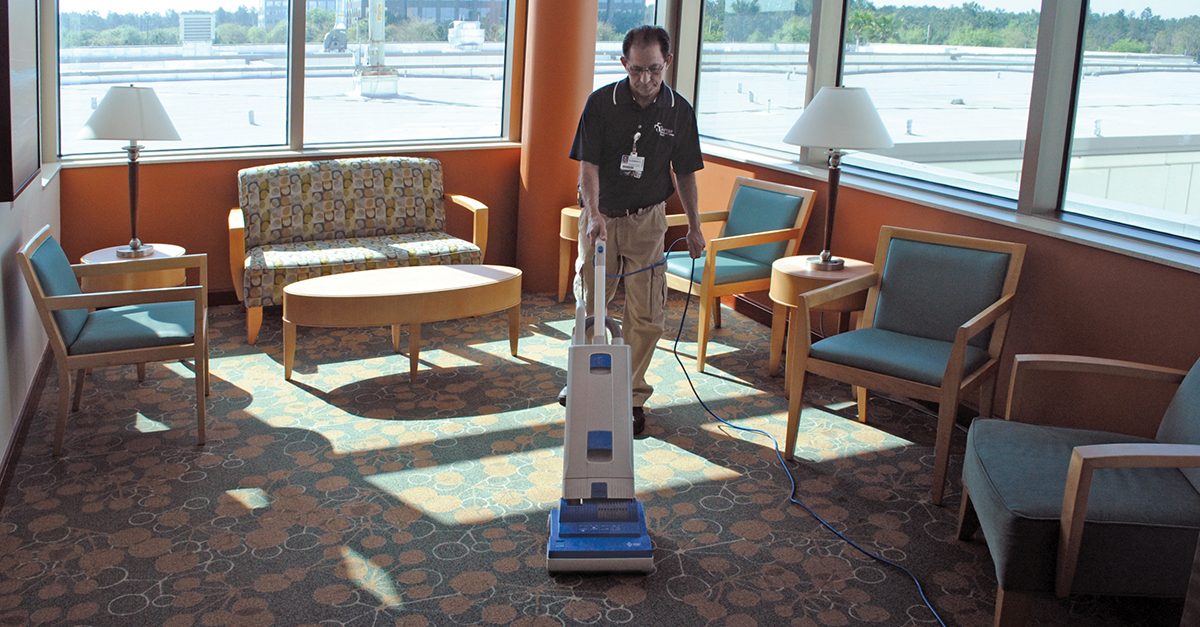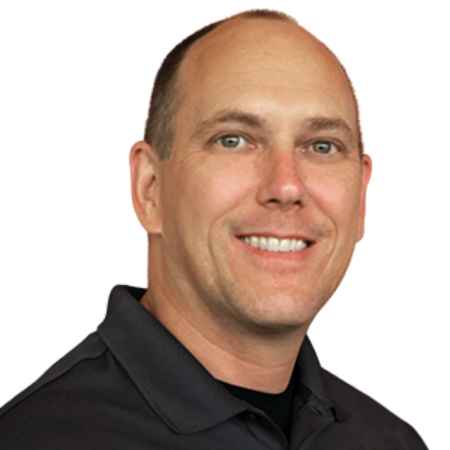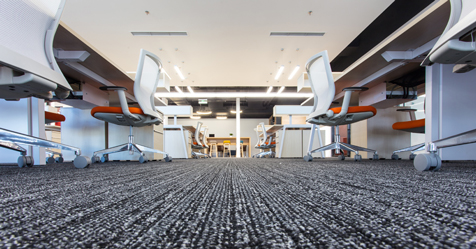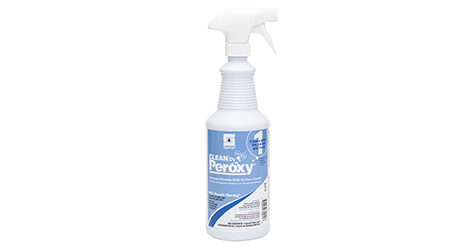Of all the surfaces in a facility, there is perhaps none more difficult to keep clean and maintain, while ensuring a good visual appearance, than carpet.
Carpet is an effective surface for a facility because it provides many benefits, such as reduced noise pollution, improved indoor air quality, and reduced slip-and-fall accidents, as well as reducing the injuries that accompany those accidents.
Developing an effective maintenance plan for your carpet is critical to its appearance and the lifecycle costs it will offer you. Many facilities have an ineffective plan for their carpet maintenance, which is centered on the notion of “cleaning the carpet when it looks soiled.” This is not an effective plan because carpet fibers are actually shaped and designed to hide soil.
When synthetic carpet was introduced to consumers more than 60 years ago, the first generation of fibers was round. The round shape of the fibers actually magnified all of the soil in the pile of the carpet, causing them to look more soiled than they actually were. This created an obvious problem for fiber producers looking to sell their product. In the 2nd generation of fibers, the manufacturers changed the shape so that it would hide soil. Today’s carpet is still manufactured with fibers designed to hide soil.
If your plan to maintain your carpets is to clean when they look soiled, you are cleaning your carpets too late. This causes damage to the fibers due to the abrasive nature of the soils that accumulate in the carpet. As a result of this damage, fibers do not reflect light evenly, the carpet develops traffic lanes that cannot be cleaned, and eventually, the carpet must be replaced to improve the appearance—an expensive consequence.
The solution is to create a program that will lower the lifecycle costs of the carpet by maintaining an acceptable level of appearance, which in turn prolongs the life of the carpeting and maximizes your investment.
Preserving Your Assets
One of the most important items to consider when putting together a program for maintaining your carpets is your true cost, or what is referred to as the lifecycle cost, of the flooring. This is your cost to purchase, install, maintain, and dispose of your flooring. Many times the cost of purchasing and installing the carpet is divorced from the cost to maintain it because of a separation between departments. What facilities fail to realize is that most of them have invested hundreds of thousands of dollars, if not millions, in their flooring, so maintenance of that flooring is not just about cleaning; it is about managing an expensive asset.
In 1994, a large national insurance company was replacing approximately 30 million square feet of carpeting every six years. A newly hired facilities manager introduced a radical idea: double the investment per square foot for cleaning and maintenance, change the processes for maintaining the carpet, and combine the costs of maintenance with the cost of purchasing the carpet to help understand the lifecycle costs.
Throughout a 20-year period, the company learned that by changing its processes and investing more in maintenance per square foot, its carpet was now lasting 12 years and the company had lowered its lifecycle cost by 22 percent (see Figure A). This was only achieved because they understood that they had invested significant money into the carpeting as well as the maintenance of the carpeting, and they considered those as one figure.
The Carpet Program Process
Start your program by focusing on the processes that you currently use, because unless you address how you clean, you will not achieve the desired results.
There are two processes that impact the life and the appearance of your carpets the most: the maintenance of exterior areas and vacuuming. Focusing on these processes addresses the dry soils that are so damaging to carpet fibers, yet many facilities do not have effective matting, sweeping, or vacuuming programs.
Overall, there are four processes that must be in place to maximize the lifecycle of your carpeting and achieve the lowest lifecycle cost. The processes that must be part of a comprehensive program are:
- Preventive maintenance: stopping soils before they enter your facility.
- Daily maintenance: removing soils that enter your facility so that the damage they cause is reduced.
- Interim maintenance: maintaining the appearance of your carpet through the use of low-moisture and low-chemical use methods that promote faster dry times and return carpet back to use quickly.
- Restorative maintenance: deep cleaning the carpet to remove deeply embedded soils and create a healthier environment.
Another item to consider is how to make employees more productive in the cleaning process. While lifecycle costs may not be a cost that environmental service directors are faced with every day, labor dollars certainly are one. The first step to maximizing your labor dollar is to determine realistic production expectations for each job.
Workloading programs are effective tools to help with this and are available through third-party providers, chemical and equipment providers, or janitorial distributors. A very simple and low-cost solution is the ISSA 612 Cleaning Times booklet, which contains 612 different cleaning functions and production rates for each of them. This allows you to set realistic expectations for production rates during cleaning. Bear in mind that the rates in the 612 Cleaning Times are averages and each facility has nuances that may affect the production rate, but it certainly will help to establish a baseline.
When investing in equipment, be sure to look for equipment with features that will make your staff more productive in the areas they clean. Wider platforms, more maneuverable equipment, and longer run times between filling equipment with water and chemical are characteristics that will help you maximize your labor dollar.
The Sad State of Soils
One of the most important concepts to understand when constructing a carpet maintenance program is dry particulate soils that are tracked into a facility are what drives the maintenance of floors and the damage of carpets. According to industry studies, 80 to 94 percent of the soil in a facility is brought in with foot traffic. Furthermore, the amounts of soil entering a facility can triple when rain or snow are present as the moisture binds the soil to shoes.
A study attributed to ISSA, the worldwide cleaning industry association, says that once soil is in a facility, the average cost to remove it is US$700 per pound. Another study attributed to ISSA shows that 1,000 people throughout the course of 20 days can track 24 pounds of soil into a facility. That means every time someone enters a facility, it costs 84 cents to remove the soil that they tracked in.
While the composition of the soil entering your facility will differ from region to region, the bulk of what foot traffic tracks into facilities is sandy, gritty particulate. The sand grinds away at whatever it contacts like 120-grit sandpaper. This is why traffic lanes develop in carpet inside doorways and why finished floors dull out so quickly. They are constantly being ground away with the grit being tracked into a facility.
The impact of soil in your facility is not only financial and cosmetic. Soil entering your facility has a direct impact on your environmental footprint. Dry soils drive the maintenance of floors, which in turn drives chemical and water usage and disposal. Furthermore, since the abrasiveness of these soils degrades the appearance of the fiber and can lead to disposal of the carpet before its useful lifecycle is completed (most carpet will “ugly out” before it will truly “wear out”), soil is a major contributor to landfills.
In 2002, the U.S. Environmental Protection Agency (EPA) estimated that 4.7 billion pounds of carpet was disposed in landfills. Since commercial carpet is primarily composed of synthetic materials, it is estimated to take 1,000 years to degrade.
Great advances have been made in diverting carpet from landfills through recycling; however, much work is still to be done. If your facility is disposing carpet, look for a Carpet America Recovery Effort (CARE) provider in your area so that the waste is diverted from a landfill.
Implementing a preventative maintenance program focused on reducing the amount of soil entering a facility is the first step to improving appearances and lowering lifecycle costs for all of your flooring, especially carpet.
Tools of the Trade
A preventive maintenance program consists of both exterior and interior matting as well as sweeping. The soils that are being tracked into your facility are primarily picked up by shoes as occupants walk into the facility. Therefore, any comprehensive program begins with the cleanliness of parking lots and walkways.
Sweepers are excellent tools for keeping parking lots and walkways clean, and when employed on a daily basis, they can dramatically reduce the amount of soil entering a facility. A small push sweeper or even a small powered sweeper requires very little investment in either purchase or labor costs. Sweeping 50 to 60 feet from a walkway on a daily basis, and—depending on your environment—even two to three times per day, can provide tremendous results.
Matting is another tool that can help to reduce the amount of soil entering a facility. While most facilities have matting, many do not have the right type of matting or the right amount of matting.
While the conventional wisdom has been that matting should allow for three to four steps to clean shoes, studies conducted by a range of matting manufacturers have shown that it takes approximately 30 to 36 feet of matting to remove 99 percent of the soil from the shoes.
There are also two different types of mats that should be employed: a ridged scraping mat outside an entrance and a carpet mat inside the facility. The function of the ridged mat is to scrape large particulate and debris from the shoes, allowing it to fall in between the ridges so that it is away from the shoes and is not carried into the facility by a later footfall. The carpet mat inside the facility wipes and dries shoes, which helps to reduce slip-and-fall hazards.
Executing Daily Prevention
Preventive maintenance is an important step and one which many facilities do not utilize properly. Remember, the more soil that enters your facility, the more it drives your floor maintenance costs.
It is inevitable that some soil will be tracked into your facility no matter how thorough of a preventive maintenance plan you have in place; that is where daily maintenance begins. Daily maintenance is the process of removing the soils that enter your facility to reduce the damage they cause. This is accomplished by vacuuming.
More than any single process, vacuuming is the key to extending the lifecycle of your carpeting. According to an industry study, 79 percent of the soil in the carpet is dry particulate soil. Dry particulate soil is what scratches and abrades fibers so that they look damaged and worn, creating traffic lanes. The most effective way to remove dry particulate soil is through vacuuming.
To take this one step further, carpet should be vacuumed before any other cleaning process is undertaken on the carpet, including before extraction or encapsulation. It is a seldom understood fact that no extraction equipment is designed to remove dry particulate soil in a wet state. To put it in more plain language: Water and dirt make mud. No extractors—truckmounted extractors included—are designed to remove dry soil in a wet, muddy state.
How to Properly Vacuum
Vacuums should be maintained and adjusted properly. This means that hoses should be free of debris, brushes should be in good working order, and vacuum bags should be checked and replaced regularly. To check your brushes, simply run a driver’s license or credit card along the face plate on both sides of the brush. If the brush contacts the card it is in good working order; if not, replace the brush.
To adjust a vacuum properly, set the dial to the highest height setting, lower the handle into a position you would use it in, and then turn the vacuum on. Adjust down setting by setting until the vacuum either begins to pull forward slightly, a change is heard in the pitch of the motor, or the dial gets to the lowest setting. Once you have reached one of these settings the vacuum is adjusted properly.
A common question is, “What vacuum should I use?” There are many choices and it can be a difficult area to make a wise decision. Essentially it boils down to two criteria: soil load and production rate.
High-soil load areas will need an upright vacuum with a brush bar to agitate the soil from the carpet. Whether you use a single motor (one motor driving the brush and creating the suction) or a dual motor (a motor dedicated to driving the brush and another dedicated to creating suction) vacuum, these areas need concentrated vacuuming. High-soil load areas will vary by facility, but here are some common areas to look for:
- The first 40 feet inside entries
- Elevators
- Outside restrooms
- Carpeted stairwells
- Areas that transition from hard surface to carpet
- Congregation points such as nurses’ stations and copiers.
High-soil load areas are the front line in your battle against soil and the damage it will cause to your floors. If soil is allowed to accumulate in these areas it will not only damage the carpet, it will spread further into the facility.
However, once the high-soil load areas have been addressed, the focus then becomes production rate and what vacuum is the fastest in the area you have to clean. To illustrate: The ISSA 612 Cleaning Times shows the production rate of an upright vacuum is between 2,239 and 4,000 square feet per hour depending on the width of the vacuum and whether it is a dual-motor vacuum or single-motor vacuum. While these vacuums may not be extremely productive, they do offer the best soil recovery and are ideal for use in high-soil load areas.
Contrast that with the vacuums typically used in the interior portions of a facility where the soil load is not as high. Backpack vacuums are rated by the ISSA 612 Cleaning Times at 7,273 square feet per hour, 28-inch wide area vacuums are rated at 10,000 square feet per hour, and stand-on vacuums offer 18,000 to 30,000 square feet of productivity per hour.
Choosing the right vacuum for areas with lower soil loads really boils down to what vacuum is right for the space being cleaned. Backpack vacuums are most effective in congested areas, such as cubicles and offices, while wide-area vacuums and stand-on vacuums are most effective in open spaces and corridors.
The Return on Investment
By creating a program that focuses on stopping soils from entering your facility through sweeping and matting, removing soils on a daily basis through vacuuming, and maintaining the appearance of the carpet through a mixture of encapsulation and extraction, you can extend the lifecycle of your carpets, help your budget and the environment, and achieve your facilities’ flooring goals.





